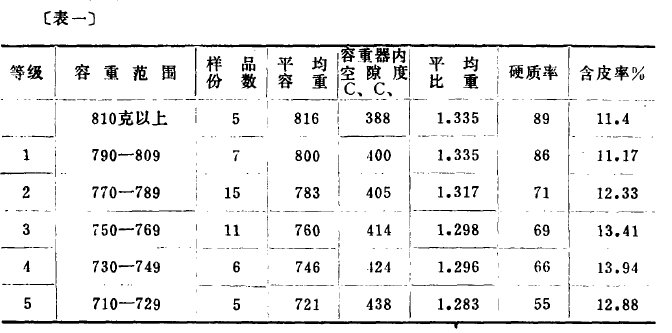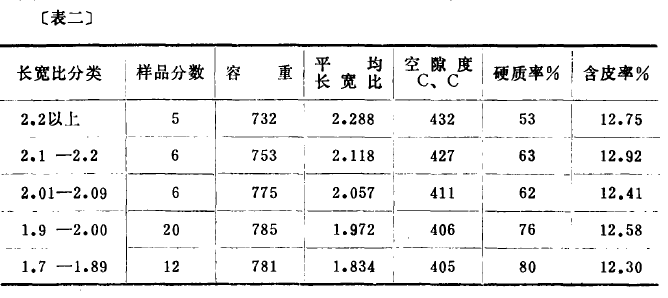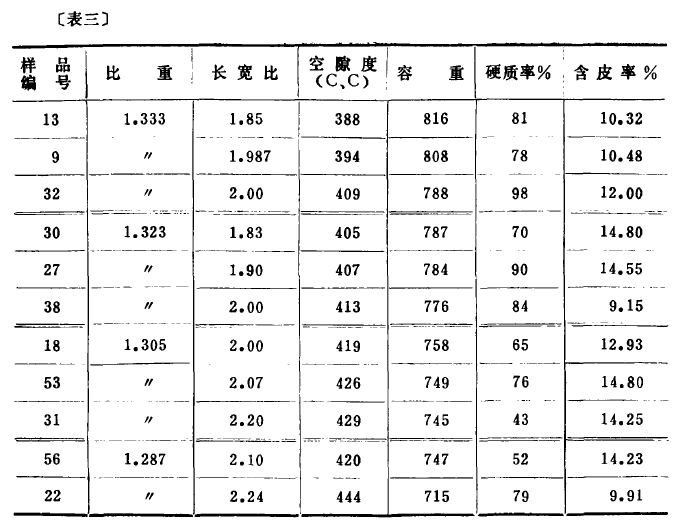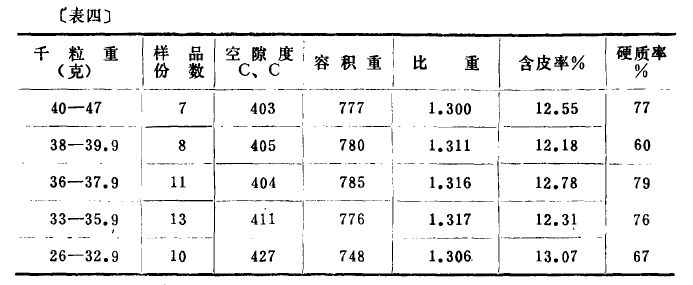The container weight is a kind of detection instrument commonly used in grain inspection in China. Wheat, sorghum and other grain species are determined by the size of the volume. The use of various types of containers to determine the weight of food containers to measure the quality of food has a long history in China. Because of the good correlation between volume and food quality and use value of food (especially wheat), in the international food trade, volume weight is often used as one of the important quality indicators of wheat. In the 30 years after the liberation of China, in the food inspection work, the use of volume reproduction as an important indicator to determine the level of wheat has played a very good role in the correct implementation of the “tank price†policy. On the other hand, during many years of practical work, some problems have often been encountered. For example, in the first-tier wheat purchased in June, the water content was below 12%, and when it was released in July and August, the volume was sometimes reduced to two. Grade, that is, less than 790 g/L. According to the experience of some wheat, the quality is good, but the bulk density is not high, and only meet the second and third standards. The opposite is true, too. Especially in recent years, there are many new varieties of wheat, and these conditions often cause controversy among members. In order to improve the understanding of the weight class for determining the level of wheat, we studied the effects of wheat's bulk density on the changes of wheat moisture from 1964 to 1965 and obtained some regular knowledge. In order to further explore the relationship between other aspects of wheat and its own weight, the experiment was conducted again in 1975. Based on the results of this experiment, a retest was conducted during the summer 1976-1977 work. This article is about some of the views on the relationship between the quality of normal wheat and the weight-bearing weight that was selected for use in 1975. We will now describe these as follows and hope that the comrades of the food inspection front will give corrections. Based on the two components of weight density and voidage, it can be clearly seen that the larger the wheat grain size is, the larger the void is and the smaller the bulk density is. At the same time, through the test results of specific samples, it is shown that the effect of air removal on the bulk density is sometimes very large. Although its quality and use value are good, due to large air removal, it causes downgrading, and some even drop two. . On the other hand, it can also be seen that the particle size is short, and in general, the particle size is short (ie, round) and the porosity is small, and vice versa. However, the aspect ratio is the same, and the voidage is not the same. This shows that, in the case of the same type of wheat, the length of the grain size is the main reason for the air dryness. However, this is not the only reason. There are also some minor causes, such as the depth of the abdomen and the smoothness of the wheat grain surface. The influence of the size of the pellets on the bulk density further explains that to make the volume more accurate than the level of the wheat, it is necessary to correctly resolve the influence of voidage on the bulk density of the wheat. Through the above table, you can clearly see the following two points: Related equipment: rice polishing machine
Color: silver, blue ect.
Surface: glossy
Application:1. Decoration:Christmas tinsel,colorful ribbons;
2.Package:Used in the Packaging of confectionery, battery Label ect.
3.Insolution:UV protection, because reflect heat radiation, be used in search and rescue for keeping people warm, and in ″proximity suits″ used by firefighters for protection from the high amount of heat released from fuel fires.
Metallized Film,Metalized Film,Metallized Pvc Film,Metallic Film Y&YTRA , https://www.pvcprod.com
I. Overview of the basic situation of the relevant load receptors This test was conducted by a test group composed of some grain banks. In conjunction with the summer campaign, a total of 131 representative samples and controversial samples were collected in the main wheat producing areas. Due to the large amount of work, 49 selected key experiments were conducted. Test items include: specific gravity, bulk density, voidage, 1000-grain weight, special width ratio, hard quality rate, skin content, etc. Among them, some items such as specific gravity, voidage, skin-containing rate, etc., lack mature detection methods, so they were determined in advance after repeated comparison tests with several methods.
Second, the two basic factors that make up the size of the volume of wheat According to the practical experience of the people, the factors that cause the weight of wheat are various. For example, the degree of wheat fullness, moisture, grain type, whether the surface of wheat grains is smooth, the depth of wheat belly ditch, the number of grains and so on. In the acquisition of wheat, the above factors are often present at the same time. It is very difficult to explain the weight of wheat by one or several specific factors, and some of them cannot be proved. Through this experiment, it has been further proved that regardless of the reason for the size of wheat's bulk density, it can be summed up as two factors. One is whether wheat itself is long enough (represented by its specific gravity), and the other is the voidage (ie, the volume of air in the container) formed when the wheat is loaded into the container. With these two factors, the reasons for the weight of a certain wheat can be explained more accurately. At the same time, it is also possible to calculate the specific grammage of the specific gravity of a certain wheat by the specific gravity or porosity, so that the quality of wheat can be improved. Get a more accurate identification. In order to more clearly illustrate the relationship between the bulk density of wheat and the specific gravity and voidage, the wheat samples tested are summarized by grade. The results are as follows: 
From the above table, it can be clearly seen that the relationship among the volume weight, the specific gravity and the voidage is very regular. That is, the ratio is significant, (wheat's full length) small void volume is high, otherwise it is low. The size of the bulk density is composed of the specific gravity and the voidage and can be further proved by the following calculations:
1. Listed in the table above: The five small swatches with a bulk density of 810 grams or more have an average weight of 816 grams, while the average weight of the first grade wheat is 800 grams, which is the same as the weight of the two, but the weight tolerance is as large as 16 grams. The reason for this is that the voidage difference between the two is 12 milliliters. That is to say, the volume of the 12 milliliters is occupied by wheat in the former, while the latter (first grade wheat) is occupied by air, such as the factors that affect the voidage. Add to it (ie: the proportion of 1.335 multiplied by the difference between the voids of the two 12 ml, equal to 16 grams) then the two weights are exactly equal.
2. For example, the difference between the average bulk density of wheat and that of the fifth grade wheat, such as Table 1 above, is 79 g. The reason for this is that the first grade wheat is longer than the other grade 5 (ie, the specific gravity is different, the weight of wheat per milliliter of wheat is equal to five. Equal weight 0.052g) Therefore, the fifth grade wheat bulk density should be 29.22g (ie: the proportion of the first and fifth grades of wheat difference, multiplied by the actual volume of the fifth grade wheat in the container) is 1000ml minus 438m). Another reason is that the fifth-grade wheat gap is 38 milliliters larger than the first wheat, which is air instead of wheat, so the bulk density should be 48.75 grams (the difference between the first-class wheat porosity of the fifth-class wheat is 38 milliliters. With the proportion of the fifth grade wheat 1.283), the total weight of the fifth grade wheat was lower by 78 grams, which is only 1 gram less than the difference between the actual weights of the two. This is due to the test weight, the number of decimal places after the gap library is rounded, and the error allowed by the operation.
The difference in the bulk density between the grades listed in Table 1 and the difference in bulk density between the samples was calculated using the above method, and the same results were obtained. The following points can be clearly seen from Table 1 and the above description:
1. Specific gravity and porosity are two factors that make up the bulk density of wheat.
2. From the general aspect, the volume weight method is able to better reflect the quality and use value of wheat. The high admissible weight, high hardiness rate, and low skin-containing ratio, conversely, low bulk density, low hardiness rate, and high skin-to-sheath ratio, clearly illustrate this point.
3. The effect of voidage on the bulk density of wheat is very large. Therefore, for some wheat, due to many reasons, the voidage is relatively large. Even though the length of wheat is relatively full, the bulk density is not high. The ability to properly address the impact of voidage will further allow the determination of wheat bulk weight to be further reasonable.
Third, the impact of the causes of wheat voidage:
In the past, there was a mixed understanding of the problem of void volume affecting wheat in the container, and the arguments were varied and researched. The understanding of the reasons for the formation of voidage has been further understood (the effect of moisture on the bulk density is expressed as follows:
1. Effect of particle size on voidage:
In general practice, the wheat grain type is divided into so-called “long grain†or “round grainsâ€. The ratio between the test and the grain width (ie, aspect ratio) represents long grain or round grain. The current list is as follows: 
From the above table, it can be clearly seen that the voidage is significantly increased as the particle size is longer (ie, the aspect ratio is larger). In addition, when the aspect ratio is 2.0 or more, the degree of increase in voidage increases. Due to the influence of the particle size on the voidage, which results in a change in volume, it can be further seen from the table below. The figures listed in the table below are the results of the determination of all samples with the same specific gravity, which are combined to further explain the influence of the particle size on voidage and bulk density. 
2. The effect of grain size on voidage and bulk density The size of wheat grain is based on the custom of the agriculture, forestry, and grain sectors, and is expressed in terms of grain weight. In the previous stage, some people thought that: Large grain wheat has a large void volume, which affects the bulk density and lowers the grade, and even puts forward opinions such as re-determination of grains. However, some disagree with this view. Therefore, disputes often occur at the time of acquisition. In order to unify the understanding, the relationship between the size of the wheat grain and the vessel and voidage was also tested. The results are shown in the following table: 
(1) For large grain wheat, the grain weight is about 46 grams, and the porosity is not large but small. This phenomenon shows that although there are thousands of grains of wheat currently available, they are not yet large enough to increase the porosity.
(2) Thousand-grain weight has no regularity in reflecting the quality of wheat (hardness rate) and use value (peeling rate), so the arguments such as 1000-grain restration are not sufficient.
Fourth, the relationship between wheat quality, use value and bulk density, ratio of Meng and grain type According to the habits of the people, in this test, the hard quality rate represents the food quality, and the skin-containing rate represents the wheat use value. The analysis and comparison of the results of the two laboratory tests with other indicators are summarized as follows:
1. From the results listed in Tables I, II, and III, it can be seen that there is no obvious regularity in the wheat use value (including the skin percentage) and the wheat grain type (length or length) and the grain size, which are similar. However, long-grained wheat and small-grained wheat have large gaps and thus have a low grade. With regard to the use value of wheat, when it is decided that it should be determined by weight, it is necessary to properly exclude the interference of voidage in order to further improve the level of wheat.
2. Through the results listed in Tables 2 and 4, we can see that the quality of wheat (according to the habits of the people, represented by the hardness rate) has nothing to do with the grain size (1000 grain weight), which means that the hardness rate of large grain granules is not necessarily high. Hardness of small-grained wheat is not necessarily low. However, small-grained wheat often results in a low grade due to large voidage. Therefore, the difference between the levels of wheat is far greater than the difference in quality.
3. It can be clearly seen from Table 1 that the bulk density and specific gravity can better reflect the use value and edible quality of wheat, especially the specific gravity, without the interference of voidage. For example, for wheat with a specific gravity of 1.320 or more, a total of 18 samples were taken from 49 samples, and the average skin-to-peel ratio was 11.8%. These 18 wheat varieties had a larger proportion, and 7 of them contained a skin percentage of about 10%. (In 49 test samples, there were only 9 copies with a skin percentage of about 10%). In terms of hardiness, among 18 wheats with a specific gravity of 1.320 or more, except for 1 part, the hardiness rate of the remaining 17 parts was over 70%, and the total average was 82%. From this we can see: "Using weight-reducing measures to eliminate the interference of voidage, so that the proportion of the greater effect in the determination, will make the determination of the weight of wheat more reasonable."
V. Discussion Questions The purpose of this test is mainly to determine the method of determining the weight of wheat and better reflect the "inside" and "quality" of wheat. In this sense, the test is basically successful. The general rule is that the weight and specific gravity of wheat can better reflect the value of wheat use and food quality. However, the weight tolerance is interfered by the porosity, which often results in good food quality and high use value. The level of wheat is reduced, so the interference of voidage is excluded, so that the proportion of wheat can play a greater role in determining the level of quality, so as to better reflect the policy of quality valuation.
In the past few years, if the weather in the wheat harvest season is good, it is not uncommon for Beijing's wheat bulk density to exceed 810 g/litre. Therefore, the social team believes that this kind of wheat should be rated as more than 20 g more than the first grade wheat crop. Wheat, otherwise it is the pressure level price. Through this experiment, it is proved that the weight-tolerance of this type of wheat exceeds 810 g/L because the wheat grain is smooth and the porosity is small. This is not the difference between the quality of food and the use value of this type of wheat compared to the first-class wheat. Etc. are reasonable. On the contrary, the wheat with good quality is only due to the size and other causes of voids that are large and declining. If not, it is unreasonable. For this reason, in the two or three years prior to the unified implementation of the national standards for wheat, during the summer levy, some methods of adjusting porosity were applied to some of the wheat to resolve some of the unreasonable phenomena such as the determination of wheat.